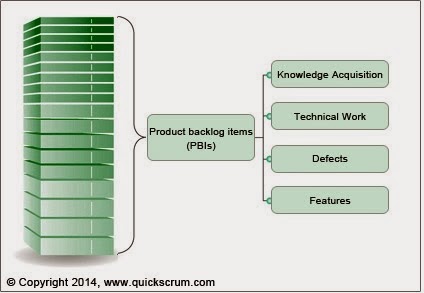One of the commonest mistakes that
people make while considering the product owner’s role in scrum is to consider
him or her as either actually owning the product, or functioning as a decision
maker while developing the product for the stakeholders. This is far from true,
since the product owner is actually employed by the stakeholders to represent
their interests while scrum is implemented in a project. A product owner can
own a product, but is not necessarily its owner in most cases.
The core job of the product owner, or
rather the main responsibility, is to:
· Figure out how to “make” the product
· Ensure that the sprints are successfully completed
during the project
· Shippable products are delivered at the end of sprints
· Ensure that the scrum project is successfully
completed
The product owner’s job is a difficult
one, and a full-time one.
The
product owner as the core determinant of a successfully completed scrum project
It is essential to
deliver value, and the scrum method requires an efficient, reliable, and an accurate
mechanism, which can help to determine the product vision and create an
effective pipeline which has the capability of distilling the product vision
into shippable, concrete, and deliverable product backlog items that can successfully
demonstrate the tangible benefits as a part of the longer project vision. It is
because of this reason that the role of a product owner becomes a very
important one while implementing scrum.
While the product owner can participate
in each Scrum ritual, his or her main function, parallel to that of the scrum master,
is to act as a facilitator for the entire team, and be available when problems
and issues arise in the project. The main tasks of a product owner are:
· Envisioning the product and facilitating its
development
· Creating an iterative or sprint release strategy which
can incorporate the changing market conditions and product requirements
· Distilling the high-level product related requirements
into developable and deliverable user stories linked with acceptance criteria
· Prioritizing the product backlog
· Communicating difficult and complex system
architecture issues to the clients
· Negotiating all client-sided disputes and concerns
associated with the product design, development, and user story priorities
Responsibilities
of a product owner
The person is mainly responsible for:
· Representing the interests of, and acting as the voice
of stakeholders and customers
· Understanding project profitability and delivering high
ROI
· Managing the stakeholders
· Maintaining communications and promoting collaboration
amongst the team members
· Undertaking on-the-spot tactical decisions and
ensuring that the product development cycle is not affected
· Participating in the release meetings and planning
· Writing effective user stories
· Maintaining and updating the product backlog
· Helping the team in estimating the development time
for each scrum scenario
· Participating in the sprint review meetings, accepting
the user stories as “Done”, and providing effectual feedback
· Monitoring the project progress and suggesting constant
adjustments based upon important strategic objectives
"Please visit http://www.quickscrum.com to download the Quickscrum tool"

